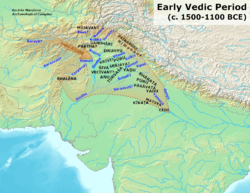Bharatas (Vedic tribe) facts for kids
Quick facts for kids Bharatas |
|
|---|---|

The Bharatas and other early Vedic tribes
|
|
| Ethnicity | Indo-Aryan |
| Location | Northern Indian subcontinent |
| Parent tribe | Puru (originally) |
| Branches | Tr̥tsu. Sr̥ñjaya |
| Language | Vedic Sanskrit |
| Religion | Historical Vedic religion |
The Bharatas were an important ancient tribe. They lived in the northern part of the Indian subcontinent a long, long time ago. This was during the second millennium B.C.E., which means between 2000 and 1000 B.C.E.
The Bharatas started their journey near the first Sarasvatī River in what is now southern Afghanistan. They were led by a brave king named Divodāsa. The Bharatas moved through the Hindu Kush mountains. There, they defeated a strong leader named Śambara.
Later, Divodāsa's descendant, Sudās, became king. He won a very important battle called the Battle of the Ten Kings. After this big victory, the Bharatas and other related tribes, like the Pūru, joined together. They formed the Kuru Kingdom. This was the first known state or kingdom in Indian history!
Contents
What's in a Name?
The name Bharata comes from an ancient language. It means "bearers" or "carriers." It's a name that suggests strength and responsibility.
A Journey Through Time
The Bharatas were a traveling tribe. Two important Bharata figures, Devaśravas and Devavāta, lived near the Āpayā, Sarasvatī, and Dr̥ṣadvatī rivers.
Devavāta's son, Sṛñjaya Daivavāta, was also a successful leader. He defeated other tribes like the Turvaśas. These battles happened in what is now eastern Afghanistan. Ancient hymns also mention a river goddess, Sarasvatī, helping a leader named Vadhryaśva. She helped him defeat his enemies.
Moving Through the Mountains
A powerful chieftain named Divodāsa Atithigva led the Bharatas. He guided them through the Hindu Kush mountains. These mountains are on the northwest border of the Indian subcontinent. Divodāsa was a great warrior. He fought against a mountain chief named Śambara for many years. Divodāsa destroyed many of Śambara's forts. This showed how strong the Bharatas were under his leadership.
Divodāsa also had allies who helped him in battles. One important ally was a wise priest named Bharadvāja. This priest helped Divodāsa plan his battles. He also received gifts from Divodāsa after victories.
Crossing the Rivers
Later, Sudās Paijavana became the leader. He was a descendant of Divodāsa. Sudās had a special priest, or purohita, named Viśvāmitra. Together, they led the Bharatas across two important rivers: the Vipāś and the Śutudrī (which are today's Beas and Sutlej rivers). This move helped the Bharatas expand their territory. Eventually, another wise priest named Vasiṣṭha took Viśvāmitra's place.
The Battle of the Ten Kings
Under Sudās and his new priest Vasiṣṭha, the Bharatas fought a huge battle. It was called the Battle of the Ten Kings. This battle happened near the Paruṣnī river (today's Ravi).
Sudās's enemies were a large group of ten tribes. These included the Pūrus, Yadu, Matsyas, Druhyus, and others. Even though Sudās's army was smaller, he won a great victory. He cleverly broke a natural dam on the river. This caused a flood that swept away many of his opponents. The Bharatas believed their patron god, Indra, helped them win.
After this, another part of the battle happened near the Yamunā river. Sudās defeated more local leaders and tribes there.
What Happened Next?
Winning the Battle of the Ten Kings was a huge deal for the Bharatas. It allowed them to take over the land of the Pūrus. This area was in Western Punjab, centered around the Sarasvatī River. This victory helped them move further east.
To celebrate his big win, Sudās performed a special ritual called the Aśvamedha. This ritual showed that he had created a strong kingdom. It was safe from enemies in the north, east, and west.
Over time, the Bharatas and Pūrus became allies. They eventually joined together to form the Kuru Kingdom. This kingdom became very important in ancient Indian history. However, there's a gap in records. So, we don't know all the details of how the Bharatas fully became the Kurus.
A Lasting Legacy
The story of the Bharatas continued to be told. In the famous epic poem, the Mahābhārata, there's an ancestor of the Kuru kings named Emperor Bharata. His kingdom was also called Bhārata.
Today, the name "Bhārata" is an official name for the Republic of India. This shows how important the ancient Bharata tribe was to the history and identity of India.
See also
- Vedas
- Vedic period
- Puru (Vedic tribe)
- Yadava
- Janapada
- Rigvedic rivers
- Historical Vedic religion
- History of Hinduism
- Indus Valley Civilization
- Outline of ancient India
- Pottery in the Indian subcontinent
- List of ancient Indo-Aryan peoples and tribes

